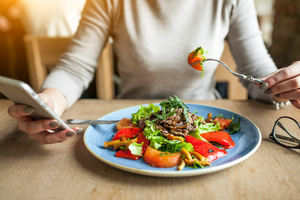Sugar may be on your mind if you have prediabetes or are at high risk for diabetes. Dietary sugar is in the foods you eat, and your blood sugar (or blood glucose) levels are all-important in prediabetes and diabetes.
The Lark DPP check-in may have alerted you to the fact that not all sugars are the same, if you were not already aware of that fact. You may have already guessed that soft drinks, cookies, and other foods with added sugars are not the best foods for preventing diabetes, but there may be good news. Foods with natural sugars, such as fruit, can be satisfying while they lower your diabetes risk.
Natural vs. Added Sugars and Their Sources

Added sugars are what you probably think of when you think of "sugar." They are sugars that are added to foods and beverages, usually to sweeten them. Soft drinks, sports drinks, flavored coffee drinks, sweet tea, cookies, candy, cake, pies, ice cream, and pastries are all examples of foods with added sugars.
Natural sugars are found naturally in foods. There is a small amount of natural sugar in beans, vegetables, and a significant amount of a sugar called lactose in milk and some other dairy products. Those do not add much sweetness or have much effect on your blood sugar, but fructose, the natural sugar in fruit, does.
Natural and Added Sugars: The Same, But Different

Take fructose, for example. It is the sugar in fruit that gives it a natural sweet taste. It is also the predominant sugar in high-fructose corn syrup, and it is half the sugar in corn syrup and white sugar.
Your body treats fructose the same no matter where it comes from. Fructose has 4 calories per gram, it gets converted to glucose in your body, and it is released into your bloodstream and raises blood sugar levels.
The difference between natural and added fructose and other sugars is the package it comes in. Fructose in soda, for example, is liquid sugar. It enters your bloodstream fast, leading to quick and high glucose spikes, and it does not provide much satiety even though it can be high-calorie. Fructose and other added sugars in sweetened foods such as cake, muffins, and cookies also tend to bring additional unhealthy components, such as saturated fat and refined starches.
Fructose in an apple or other types of fruit, however, brings along with it a load of dietary fiber, which slows digestion, helps stabilize blood glucose levels, and satisfies hunger for a while. Apples and other fruit are low-fat, low-calorie, and linked to lower diabetes risk. You can also choose fruit as a sweet treat that fits well in a weight loss plan.
Sweeter Satisfaction with Healthier Choices

In general, it is best to limit added sugars as much as possible. You can do so by cutting back on portion sizes, such as having half of your usual dessert size, and by making lower-sugar choices when you can. For example,
- Choose water instead of a soft drink.
- Try fruit instead of a sugary dessert.
- Try frozen bananas or grapes instead of ice cream.
- Use more cinnamon and less sugar in your oatmeal.
- Choose plain instead of sweetened flavored oatmeal, and unsweetened breakfast cereal instead of sweetened cereal.
- Read labels to choose lower-sugar foods.
Lark DPP can guide you as you try to lower your sugar intake to lose weight, stabilize energy levels, and lower diabetes risk. Keep logging in to see how you can make better choices, one small step at a time, that can add up to big benefits.











.webp)








